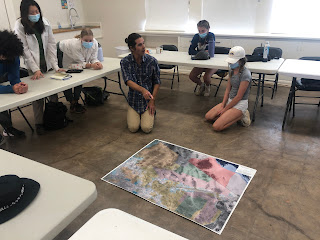Day 5 - Humanitarian Aid, Copper Mining, and Seguaro Cactus
By Parker and Aaliyah,
To start the day off, we met with Scott Warren, who was the subject of a documentary we studied before coming to Southern Arizona. We asked many questions about the current and past border situation, talking a lot about the humanitarian aid provided to immigrants and how the environment had been negatively affected by the construction of the wall. To start, we learned about the great amount of water pumped from the nearby environment and how it negatively affected its surroundings. Additionally, we talked about how the wall prevented the migration of not only animals, but also humans, who have migrated for thousands of years to meet their needs.
Next, we were lucky enough to enjoy a delicious brunch at the inn, having the luxury of trying Mimi's famous potatoes. Continuing to enjoy the company of Scott Warren, we devoured our flamboyant brunches, finishing every crumb on our plates. After brunch, many filming groups were grateful to be able to conduct an interview with Warren, learning many interesting things. Some of the things we learned about undocumented people crossing the border were upsetting to some people; however, as a group we were able to get through the discussion.
After brunch, we had a quick siesta before heading to meet Tara from the Humanitarian Aid Center of Ajo. We learned many facts about the legal aspect of immigration to and from Mexico along with the many efforts made to help those in need making the treacherous journey across the border. After an interesting discussion, we were given some free time to explore the town and its shops.
Then, we reconvened with our group and embarked on a tour of the old copper mine and its neighboring museum. The copper mine, which is now closed, used to be the epicenter of the town's economic life, and the town was devastated by its closure: Ajo's previous population of 12,000 individuals, dropped greatly to around 3,000 people. This great drop in population was mostly due to the town's dependency on the copper mine's economic contributions. We learned how the copper mine had a devastating effect on the town but also how the civilians had come together to create a more sustainable town in the wake of the closure.
After another siesta, we came together again to work with our video groups on our project, with a focus on pulling together an interesting story with the interviews we had conducted.
Next, we took a short drive to meet with a Tohono O'odham indigenous man from this area named Victor. With Victor, we listed to a native song and learned a lot about his native tribe. Victor showed us how to harvest fruit from the Seguaro cactus, using the dead Seguaro skeletons. From these skeletons, we broke off many different stocks which people would then generally tie together to create a tool to be able to reach the top of the plants where the fruit was present. Together, we chopped and transported the stalks. Victor taught us about various practices which his native tribe had used to live sustainable lifestyles.
Finally, we came back to our hotel where we all cooked dinner together and enjoyed a nice meal by the fire pit.
















Comments
Post a Comment